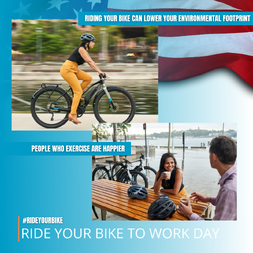Training Tips for a Beginner Cyclist
.jpg)
First Weeks of Training for Cycling
The first thing to do to get started is to ride your bike more than you did last week. If you haven’t been riding your bike on a regular basis, start by riding three to five times for 30-60 minutes each time. If you’ve been riding recreationally or for transportation, figure out a ballpark for how much time you’ve been riding on a weekly basis and increase by 10%. Don’t start with intensity; start with volume of time (not KM count) and add intensity later. Your pace on the bike should be conversational. This means that you could speak in full sentences to someone riding with you. If you are gasping for breath or can only say two word sentences, then this is too fast or hard paced.
First Month of Training for Cycling
Cyclists who were not riding on a regular basis before starting to train should continue building volume by increasing weekly riding time by 10% each week, over the course of 3-6 rides. Rest days – no training – at least one day out of seven is a strong recommendation as recovery helps you get stronger (something people tend to forget). If wanting to really add hours for the week try one longer weekend ride. Try going a little longer on one day of the weekend (Or a day in which you are not working). You can add training volume by incrementally making each ride longer by 15 mins each week.
Three Months into Training for Cycling
Riding more hours can only take your fitness so far, especially once most working people hit their maximum training time at 6-10 hours per week. So increasing workload to increase fitness is done by increasing volume and intensity. If you have reached the maximum volume (time in total per-week), then you can look at including some intensity. That’s where intervals come in. There is a huge range of information from the internet, cycling magazines to training-specific books. I would recommend no more than two rides a week that have intensity in them. You might be ready to start doing bunch rides. This is a great way to learn how to ride with others, be in a tight bunch, be in a pace line, and how to ride in the wind with a group. Your local club or bike shop may help you find some local bunch rides suitable for a beginning cyclist.
Nutrition For Cycling Training
As you increase your weekly caloric expenditure it is important to make sure your caloric intake is sufficient to meet your needs. Most people consume more than enough calories, and one of the big mistakes people make is to increase caloric intake way more than necessary as they start training. One way is to get in tune with your body and eat to your hunger needs. Hydration is important. Always have water in bottles on any length ride. Anything under 60 minutes, plain water will be sufficient unless it’s a high intensity workout. No additional calories are needed during workouts that are 60 minutes or shorter. Consume carbohydrates during workouts longer than 90 minutes. There is a huge marketing ploy to get you to buy energy bars, gels, and drinks. However, bananas, dates and other natural products are just as good. Muesli bars from the supermarket are adequate. Selecting a sports powder to put in your drink bottles is a good way to help you with electrolytes lost in sweat. As you get into cycling more, you can research more what is best for you and what works personally best for your body system.

Moving from Beginner Cyclist to more serious cyclist
Ideally, the experience of getting started with training inspires you to continue developing fitness and participating in challenging cycling events. While you can certainly continue to make progress directing your own training or absorbing information from the cycling community, here is when you may employ a coach to take you to your next level.
Jakub Novak at Pro Cycling Coaching is a former professional road cyclist with over 11 years cycling experience at the highest level. He has been passing on his valuable experience as a coach since he retired from professional cycling. Check out his website for more information.
Leave a comment
- Training Tips for a Beginner Cyclist
- Industry Reviews
- Mountain Bikes Buyer's Guide
- Polygon Siskiu T8 vs Collosus N9
- Superior XP919 Review: An Affordable Cross Country Marvel
- Mountain Bikes vs. Road Bikes: Which Is Safer for Your Cycling Adventures?
- Drop bar Buyer's Guide
- Are Electric Bikes Safe? Unpacking the Truth for New Riders
- Commuter Bike Guide
- Essential Bike Accessories for Every Cyclist
- Ultimate Guide to Buying Cycling Gear Online
- Is a Mountain Bike Good for Commuter Use? Exploring Versatility and Performance
- Is It Worth Buying an Ebike? Weighing the Pros
- Pinned With Polygon | The gang goes to Crankworx
- EWS #5: Burkville
- Sustainable Strategies
- Worth-it Blogs EP#3: Budget Hardtail Upgrades
- Worth-it Blogs EP#2: Hardtail Hitters
- The Bicycles Online's Company Fitness Challenge
- Bikes Online Does Sea Otter
- Choosing the Right Mountain Bike: Polygon Siskiu T6 vs. T9
- The Amazing Do-It-All Trail Bike: Polygon Siskiu T8 Review
- Polygon Siskiu D7 vs T7: Finding the Best Bike
- Guide to Polygon Siskiu T Mountain Bikes
- Upgrading Your Mountain Bike Suspension: A Guide to Fork Selection
- Bikepacking 101
- Fox vs. Rock Shox: A Comprehensive Comparison of Mountain Bike Suspension Giants
- 27.5 vs 29 Mountain Bike Wheels: An In-depth Comparison
- The Ultimate Guide to Choosing the Right Gravel Bike
 USA
USA AUS
AUS









